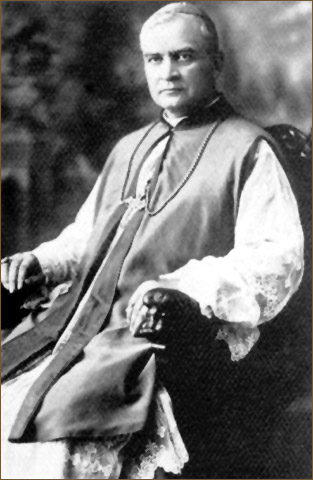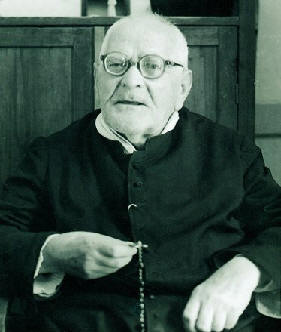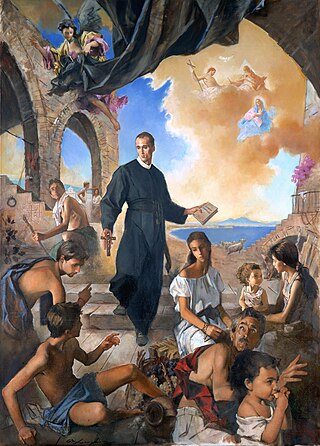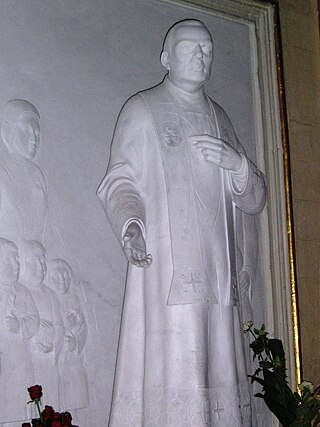
Blessed Anton Martin Slomšek was a Slovene Roman Catholic prelate who served as the Bishop of Lavant from 1846 until his death. He served also as an author and poet as well as a staunch advocate of the nation's culture. He served in various parishes as a simple priest prior to his becoming a bishop in which his patriotic activism increased to a higher degree since he advocated writing and the need for education. He penned textbooks for schools including those that he himself opened and he was a vocal supporter of ecumenism and led efforts to achieve greater dialogue with other faiths with an emphasis on the Eastern Orthodox Church.

Józef Bilczewski was a Polish Roman Catholic prelate who served as the Archbishop of Lviv from 1900 until his death. He served as a theological and dogmatics professor in the Lviv college after himself having earned two doctorates in the course of his own studies. He earned a reputation as a learned and cultured man; these qualities led to Emperor Franz Joseph I nominating him for the Lviv archdiocese as its head. Pope Leo XIII named him as its archbishop and he set to work prioritizing a range of different pastoral initiatives aimed at revitalizing the faith within people and also prioritizing ecumenical cooperation with other denominations.

Jurgis Matulaitis-Matulevičius, also known as Jerzy Bolesław Matulewicz-Matulaitis was a Latin Church Catholic prelate who served as the Bishop of Vilnius from late 1918 until his resignation in 1925. Matulaitis was also the founder of the Sisters of the Immaculate Conception and the Handmaids of Jesus in the Eucharist; he served as the Superior-General of the Marian Fathers from 1911 until his death. He worked in secret to revive the Marian Fathers after the Russian authorities suppressed all religious orders and he even relinquished his teaching position to better dedicate himself to that secret revival. He was a noted teacher and spiritual director who set up other branches of the order in places such as Switzerland and the United States far from Russian authorities.

Gaetano Catanoso was an Italian Catholic priest and the founder of the Suore Veroniche del Santo Volto (1934). Catanoso served as a parish priest in two different parishes for his entire ecclesial life and was an ardent devotee of the Face of Jesus which he promoted to the faithful. He also founded the Poor Clerics to encourage vocations to the priesthood while forming the Confraternita del Santo Volto (1920) to spread devotion to the Face of Jesus. He dedicated his pastoral career to bringing the Gospel message to all people and hiked or rode on a mule to reach distant and surrounding mountain villages in order to evangelize to people.

Gennaro Maria Sarnelli was an Italian Roman Catholic priest and a professed member from the Redemptorists. Sarnelli was one of Alphonsus Maria de' Liguori's earliest companions and a prolific writer on a range of religious topics. He wanted to become a Jesuit though was dissuaded from this before working in the Hospital of the Incurables where he call to the priesthood blossomed. His apostolic zeal knew no limits: he preached missions and aided his friend Liguori in his work; he tended to the sick and helped to get girls out of prostitution despite the threats levelled against him.

Filippo Smaldone was an Italian Roman Catholic priest and the founder of the Salesian Sisters of the Sacred Hearts. Smaldone is best known for his extensive work with the deaf during his lifetime. Smaldone was a gifted preacher known for his commitment to proper catechesis and to the care of orphans and the mute, which earned him civic recognition.

Johannes Ludovicus Paquay, also known as Valentinus, was a Belgian Roman Catholic priest and a professed member from the Order of Friars Minor. He was a popular confessor and noted preacher while serving in various leadership positions in the house he was stationed in; he was also known for his popular devotion to the Eucharist and the Sacred Heart and promoted these devotions to the faithful and to his conferees alike.

Edward Poppe was a Belgian Roman Catholic priest who advocated for the frequent reception of the sacraments and established a children's league dedicated to the Eucharist; he was a strong critic of Marxism and materialism as well as rampant secularism in his region. As a writer and pastor, he advocated for the rights of common laborers. He started his ministry in Ghent but ill health forced him to move.

Nazju Falzon was a Maltese cleric and a professed member from the Secular Franciscan Order. He did not become an ordained priest because he did not feel he was adequate enough for such an honor. He became an apt catechist and noted for his commitment to religious instruction.
Paolo Manna was an Italian Roman Catholic priest and a member from the Pontifical Institute for Foreign Missions as well as the founder of the Pontifical Missionary Union. Manna worked in the missions in Burma and even served as the Superior General for PIME. Manna did much in his life to promote the missions and the evangelic and apostolic zeal that accompanied it and he established newspapers and movements to help promote this charismatic apostolate. He also held several leadership positions in PIME and used that standing in order to further engage with prospective missionaries.

Stanisław Kazimierczyk was a Polish Catholic priest and a professed member of the Canons Regular of the Lateran. He became noted for his ardent devotions to both the Eucharist and to his personal patron saint, Stanislaus of Szczepanów, as well as for his charitable dedication to the ill and poor of Kraków.

Louis Brisson, OSFS was a French Roman Catholic priest and the founder of both the Oblate Sisters of St. Francis de Sales and the Oblates of St. Francis de Sales. He founded the female branch alongside Léonie Aviat and the male branch alongside the Servant of God Thérèse Chappuis. Brisson's founding of the congregations stemmed from his desire to improve the working conditions of middle-class girls and to ensure their protection and the promotion of their faith.

Blessed Jacinto Vera Durán was a Uruguayan Roman Catholic prelate who served as the first bishop of Montevideo. He was an active minister in Uruguay, although his efforts to renew the priesthood and other ecclesial initiatives brought him into conflict with the Uruguayan government; this was the cause of his exile from the country, establishing himself in Buenos Aires between October 1862 and August 1863, at which point a political change in Uruguay made his return possible. The popularity showcased by his reception continued throughout the rest of his life due to his intense and prolonged missionary work all over the diocese of Montevideo, of which he was made bishop upon its creation in 1878. A neighborhood of Montevideo was named after him in 1895.

Miroslav Bulešić was a Roman Catholic Croatian priest. He studied in Rome before being recalled to his native Istria where he was ordained in 1943 during World War II prior to two parish postings where he became a vocal critic of Communism. He renewed his parishes through well-organized pastoral activities and was a promoter of frequent sacramental reception. But his criticism of Communism saw him make enemies who soon set upon and succeeded in killing him.
Luca Passi was an Italian priest and the founder of the Teaching Sisters of Saint Dorothy. Two brothers of his were priests – following the example of their paternal uncle – and Passi himself moved to Venice in order to dedicate himself to both his preaching and educational missions.
Francesco Spinelli was an Italian Roman Catholic priest and the founder of the Sisters Adorers of the Blessed Sacrament. Spinelli became close contemporaries of Geltrude Comensoli and Luigi Maria Palazzolo and had a previous collaboration with Comensoli in which the two established a religious institute in Bergamo before a rift between members caused Spinelli to distance himself from its work and leave.

Anton Maria Schwartz, born Anton Schwartz, was an Austrian Roman Catholic priest and the founder of the Congregation of the Christian Workers of Saint Joseph Calasanz. He entered the novitiate of the Piarists but left due to fear of German suppression so instead became a diocesan priest for the Archdiocese of Vienna. He championed the rights and the welfare of the workers and aimed his order at serving labourers.

Pietro Bonilli was an Italian Roman Catholic priest and the founder of the Sisters of the Holy Family of Spoleto. Bonilli served as a diocesan priest for his entire life in both Trevi and Spoleto while using his order to reach out to orphans and homeless people.
Giuseppe Baldo was an Italian Roman Catholic priest and the founder of both the Little Daughters of Saint Joseph (1894) and the Sisters of Charity of Saint Mary (1882). Baldo served as a simple parish priest in the Diocese of Verona and tended to the old and the poor.
Juan Nepomuceno Zegrí Moreno was a Spanish Roman Catholic priest and the founder of the Mercedarian Sisters of Charity (1878). Moreno was ordained as a priest in 1855 and was accused of misconduct in 1888 and the Holy See ordered him to leave the congregation as an investigation took place; he was vindicated in 1894.















